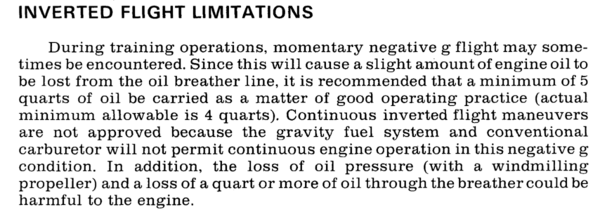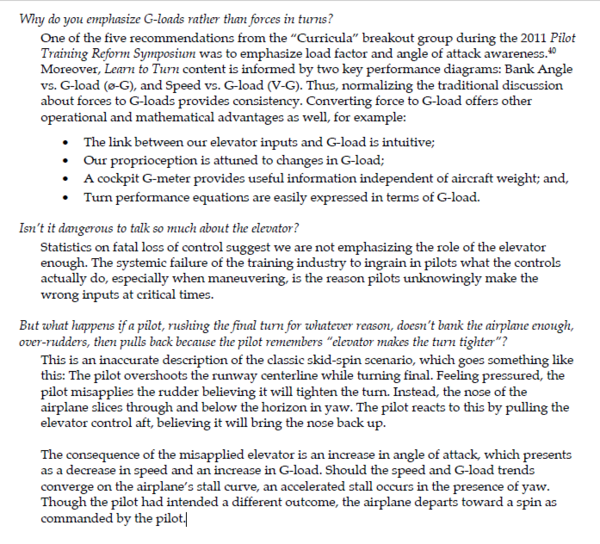
djpacro
-
Posts
2,948 -
Joined
-
Last visited
-
Days Won
16
Content Type
Profiles
Forums
Gallery
Downloads
Blogs
Events
Store
Aircraft
Resources
Tutorials
Articles
Classifieds
Movies
Books
Community Map
Quizzes
Videos Directory
Posts posted by djpacro
-
-
19 hours ago, rgmwa said:
Having learned to fly in one, I can vouch for their toughness too, although the door had a tendency to pop open, and you were literally rubbing shoulders with the instructor.
Pilots were narrower back when the 150 was designed. Standard pilot weight for design was 77 kg for many years. They conceded a little with the bowed doors in 1967 to give extra elbow room.
-
The 150/152 is a great trainer, including spinning and aerobatics (the last in the Aerobat of course).
-
 1
1
-
-
1 minute ago, APenNameAndThatA said:
Was in a Decathlon with my instructor. I could spin easily from a side slip: the high wing dropped and just kept going.
A sideslip is inherently spin resistant so I guess that you did something other than keep the sideslip straight just prior to the stall?
QuoteIn a skidding turn it just kept kind of mushing even with rudder into the turn and the stick back and out of the turn. 🤷♂️I probably wasn’t positive enough with my inputs. After what I had heard, I expected to invert with only slightly crossed controls. Maybe I would have in a Cessna.
The Decathlon is very docile, there is a sweet spot of airspeed, power, rate of turn and pitch etc where it will aggressively enter a spin with little warning. The Cessna 150 does it much better, trainee instructors would typically go around a couple of turns in a spin if they weren't expecting it.
-
 1
1
-
 1
1
-
-
I hadn't landed a Pitts in over a year so my brain was a bit rusty.
-
 10
10
-
 1
1
-
-
12 hours ago, walrus said:
Yes, I get the message they are sending. They don't want RAA aircraft at all.
That is the consequence of some people using airports without paying. If you can talk to the General Manager Aviation my guess is that he'd be OK and nil fees.
-
3 hours ago, Flying_higher said:
Check the YMMB website for charges. Last time I looked there was a $560 (i think) parking charge for non-VH registered aircraft.
Per 1000 kg pro-rata
-
I witnessed an accident where an unlicensed pilot was trying to take off in an unregistered aeroplane. He destroyed one aircraft and damaged another. Got his aeroplane trucked away within a few hours. I spoke to the guy who's aeroplane was destroyed. CASA took no interest because he did not break any of their rules, if it had lifted off the ground then it would've been a different matter. Neither did the police. Just one vehicle crashing into another on private property.
-
 2
2
-
-
31 minutes ago, Garfly said:
A UNICOM service is a basic aerodrome information service: it is not an Air Traffic Service.
The next level up at a non-controlled aerodrome is a certified air/ground radio service (CA/GRS) per https://www.casa.gov.au/sites/default/files/2021-08/advisory-circular-139-d-02-guidelines-certified-air-ground-radio-services.pdf
-
 1
1
-
-
13 hours ago, ClintonB said:
Long as you know the right speeds it is fine. cessnas hand book is all in MPH and dial in Knts, it is a pain reading pencil scribbles next to all figures.
Courtesy of CASA and the great flight manual debacle. Many years ago all aircraft here required Australian-specific flight manuals and ASI's to be in kts so all American airplanes had to be converted. Around 2001 CASA reversed and required all aircraft to use the original flight manual. So, now people end up with ASIs in kts and the flight manual using mph. Airplanes which had been operating for 30 years now had to get their original flight manual - at least one aircraft manufacturer refused to respond to such requests for airplanes that old.
-
 1
1
-
-
2 hours ago, Thexder said:
I've seen guys take-off 20kg over weight because "I've got a big engine and she'll lift anything" when they haven't considered the forces on the plane during turbulence, or guys think the yellow arc on the ASI is the turbulence penetration speed.
I always consider the forces on the airplane ..... https://www.avweb.com/flight-safety/technique/turbulence-v-speeds/ Do the sums on gust loads.
Manoeuvring loads and structural fatigue are adversely affected by overweight operation. So is performance but, as you say, a big engine is good. 20 kg .... 3% maybe .... almost trivial compared to those aeroplanes found to have incorrect empty weights a while back along with a gross error in crew moment arms so their CG was way further aft. Fixed by adding mass on the engine - a much bigger % increase - what effect does that have on the engine mount and forward fuselage structure?
-
 1
1
-
-
I would and I do.
Class D towers wouldn't specify a speed as they don't know what my airplane is capable of.
-
 1
1
-
 1
1
-
-
https://www.aircraftspruce.com/catalog/appages/gapseal.php
Effectiveness depends on the design of the ailerons you have and the size of the gap. Some designs are not intended to have the gap sealed.
-
 1
1
-
-
Instrument screws are brass for a reason https://www.aircraftspruce.com/catalog/hapages/brassinstrscrew2.php
-
 1
1
-
-
4 hours ago, GraemeK said:
It was at the Shell servo at Laverton, but I don't know any of its history!
Fleetwings, I used to visit it often. I’m pretty sure that it has been restored and flying now.
-
-
4 hours ago, facthunter said:
Plenty of aerobatic aircraft didn't have negative gravity oil systems. …..
And quite a few with VW engines, the Corby Starlet for one.
-
 1
1
-
-
An inspiration to the rest of us!
-
 4
4
-
-
On 31/12/2021 at 10:51 AM, FlyBoy1960 said:
Why is the Jabiru such a difficult plane to fly?
Seems to require above average pilot skills for what is generally a low performance aircraft by comparison with some others.
It needs more development in the area of handling qualities.
-
 1
1
-
 1
1
-
-
Easy enough to demonstrate roll due to rate of yaw - fly an airplane with nil dihedral (ideally a mid-wing, which I owned for many years) through a hammerhead/stall turn. See the different behaviour depending on whether you fly a good vertical (wings developing zero lift) vs wings developing a bit of lift.
-
 1
1
-
-
11 hours ago, APenNameAndThatA said:
I don’t understand the bit about getting another instructor. And I googled it and I dont understand the bit about Frise ailerons. When I was spinning the Extra, I used opposite stick and rudder directions, so it was not just the instructor’s way of doing things.
Apologies, I must've misunderstood your comments about your instructor.
The effect of aileron in a spin for the Cessna (which has Frise ailerons) is significantly different than for the Decathlon, the opposite effect in some situations. (Cessna published a comprehensive document on spinning.)
-
14 hours ago, APenNameAndThatA said:
But my instructor said that if you put in forward elevator when you are inverted in the autorotation you might stay inverted.
The autorotation stage is a mystery to me. And my instructor literally does not know when the stall ends and the autorotation starts. 🤷♂️ I brought that question up here before and no one else seemed to either.
Suggest that you try another instructor.
Reading CASA AC 61-16 may assist.
14 hours ago, facthunter said:The Decathlon probably has Frise ailerons ..... There's a big difference from some planes to others and you should know what's specific to the type. You are not supposed to be test pilots. Nev
Totally agree with that bit except about the Frise ailerons.
-
On 10/12/2021 at 11:00 AM, APenNameAndThatA said:
I did my first lot of upset and recovery training yesterday. I ***KNEW*** that if your aircraft is inverted, you don't pull back on the stick. And before the manoeuvre, my instructor said, over and over, that if you are inverted, you roll the aircraft level to the nearest horizon. When I was inverted, I still automatically recovered by pulling back on the stick and doing half a loop so I was upright again.
Let us know how you go with the course. Hopefully you get the full, complete theory and enough practice that the techniques stick (for a while) and you don't automatically do the wrong thing in their scenarios.
-
Quote
Upset prevention and recovery training (UPRT) has been developed during the last decade to address the category of accidents ascribed to loss of control in-flight (LOC-I).
Rich Stowell, considered a “father” of UPRT, looks at another way to approach LOC-I mitigation with a webinar presented by Aviation Performance Solutions (APS), “Learn to Turn: Laying the Foundation for Proper Upset Prevention and Recovery Training Skills.”
from https://www.flyingmag.com/aps-webinar-featuring-learn-to-turn-rich-stowell/
QuoteReleased to the aviation community in September, the free Learn to Turn program takes a stick and rudder approach to reducing loss of control. This webinar focuses on increasing awareness of the consequences of your control inputs and describing training exercises designed to improve your basic flying skills. Master Instructor Rich Stowell shares tips and techniques that will help you be a better and safer pilot.
-
 1
1
-
 1
1
-
-
21 hours ago, APenNameAndThatA said:
What you are taught fist sticks most. Instead, people should be taught that the elevator controls angle of attack.
Yes indeed. Many pilots are surprised when I talk to them about that.
A good primer for UPRT is
https://www.faa.gov/regulations_policies/handbooks_manuals/aviation/airplane_handbook/media/06_afh_ch5.pdfUA recoveries from failed aerobatic manoeuvres in an aerobatic course share some of the elements of UPRT and unfortunately some schools have simply rebadged their extreme UA recovery courses as UPRT.
My advice for people looking for UPRT is to see what EASA specifies for their Advanced UPRT course and compare that with what is being offered.
https://www.apstraining.com/resource/easa-advanced-uprt-requirements-are-a-big-step-toward-reducing-loc-i-fatalities/QuoteHow Does EASA Define UPRT?
The Advanced UPRT course in Europe is seen as an important step towards enhancing a commercial pilot’s resilience to the psychological and physiological aspects often associated with upset conditions. The required Advanced UPRT course must include at least 5 hours of theoretical academic instruction as well as at least 3 hours of dual flight instruction in an airplane. The original designers of the EASA solution intended for the 3 hours to be in delivery of actual UPRT in the training area, not block time. 3 hours in the training area is enough. Based on APS’s three decades of UPRT experience delivering UPRT, 3 hours of block time is unacceptably low to deliver effective UPRT that will make a difference in safety.
-
 2
2
-



Stalls are more scary than spins.
in Student Pilot & Further Learning
Posted
All certified types must have the spin recovery method in the AFM and/or placarded.
For those types not approved for intentional spinning then that correct recovery method must be initiated within one turn to ensure recovery.
Interesting that most I encounter have a different spin recovery technique than types commonly used for spin training.